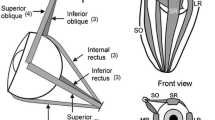Abstract
In experiments described in the literature objects presented to restrained goldfish failed to induce eye movements like fixation and/or tracking. We show here that eye movements can be induced only if the background (visual surround) is not stationary relative to the fish but moving. We investigated the influence of background motion on eye movements in the range of angular velocities of 5–20° s−1. The response to presentation of an object is a transient shift in mean horizontal eye position which lasts for some 10 s. If an object is presented in front of the fish the eyes move in a direction such that it is seen more or less symmetrically by both eyes. If it is presented at ±70° from the fish's long axis the eye on the side of the object moves in the direction that the object falls more centrally on its retina. During these object induced eye responses the typical optokinetic nystagmus of amplitude of some 5° with alternating fast and slow phases is maintained, and the eye velocity during the slow phase is not modified by presentation of the object. Presenting an object in front of stationary or moving backgrounds leads to transient suppression of respiration which shows habituation to repeated object presentations.
Similar content being viewed by others
Author information
Authors and Affiliations
Additional information
Accepted: 14 April 2000
Rights and permissions
About this article
Cite this article
Schaerer, S., Kirschfeld, K. The role of background movement in goldfish vision. J Comp Physiol A 186, 583–593 (2000). https://doi.org/10.1007/s003590050010
Issue Date:
DOI: https://doi.org/10.1007/s003590050010




